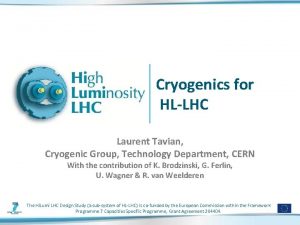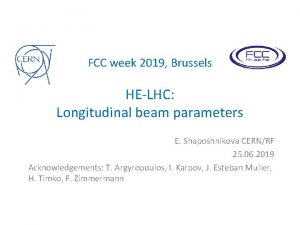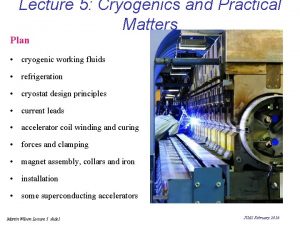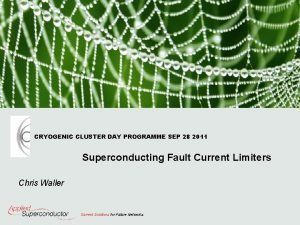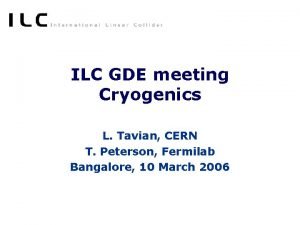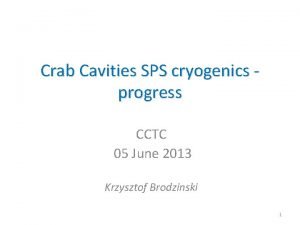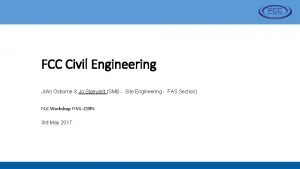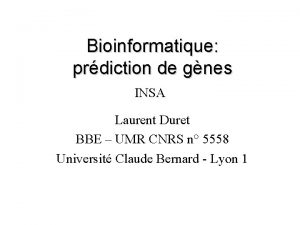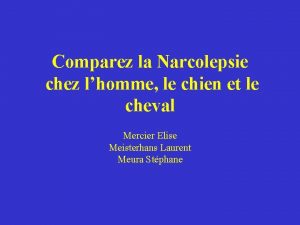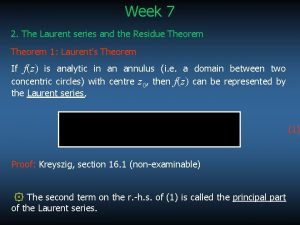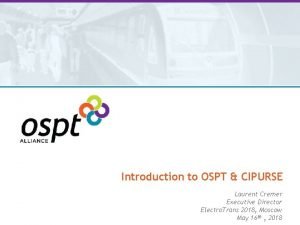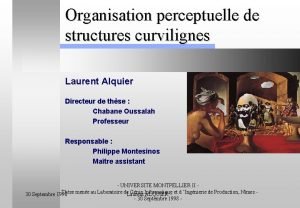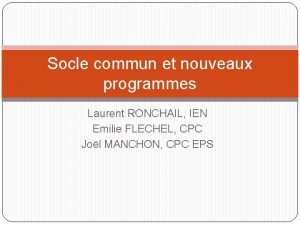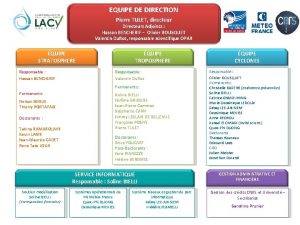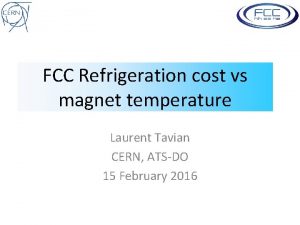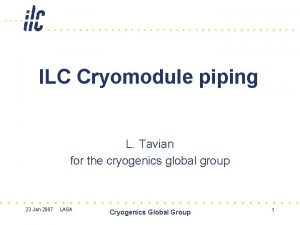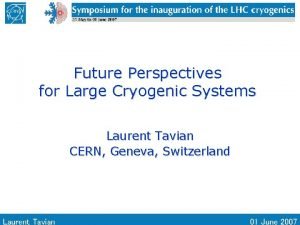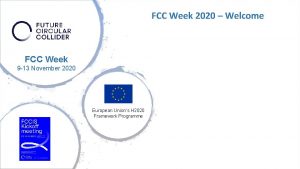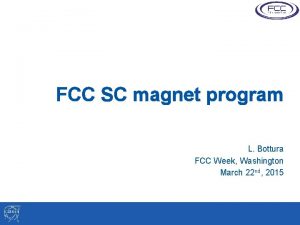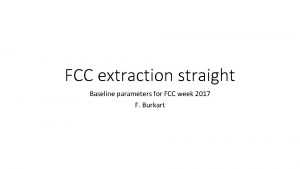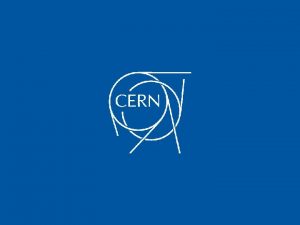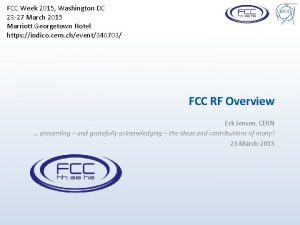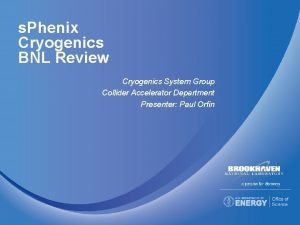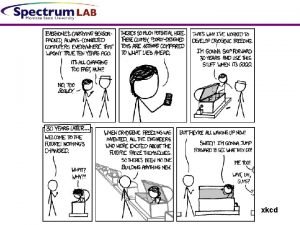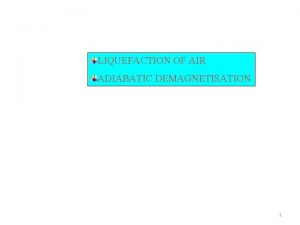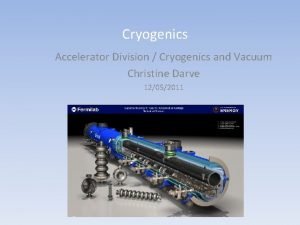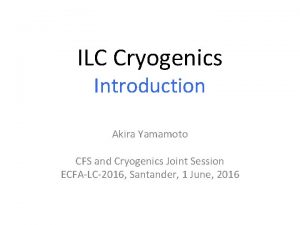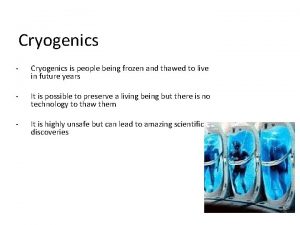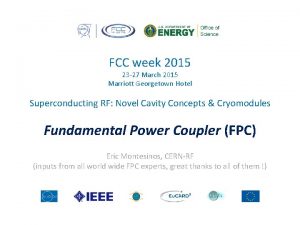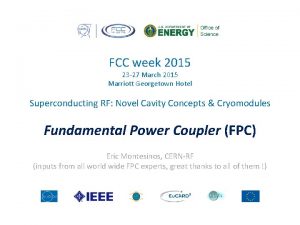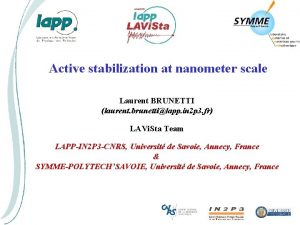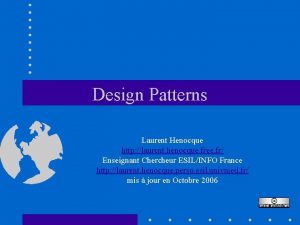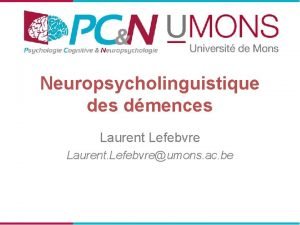FCC Week 2015 Washington Cryogenics Laurent Tavian CERN






![Rough heat load estimate LHC [W/m] Temperature level CM supporting system 50 -75 K Rough heat load estimate LHC [W/m] Temperature level CM supporting system 50 -75 K](https://slidetodoc.com/presentation_image_h2/75805b6bcf81dca63d67317a990e9e42/image-7.jpg)
![Current lead cooling Rough scaling from LHC: LHC FCC-hh Dipole Current [k. A] 12 Current lead cooling Rough scaling from LHC: LHC FCC-hh Dipole Current [k. A] 12](https://slidetodoc.com/presentation_image_h2/75805b6bcf81dca63d67317a990e9e42/image-8.jpg)










![RF data : 120 Ge. V, 12 m. A 1 -cell RF voltage [MV] RF data : 120 Ge. V, 12 m. A 1 -cell RF voltage [MV]](https://slidetodoc.com/presentation_image_h2/75805b6bcf81dca63d67317a990e9e42/image-19.jpg)



- Slides: 22

FCC Week 2015, Washington Cryogenics Laurent Tavian CERN, Technology Department 26 March 2015

Content • Introduction: FCC cryogenic study organization • FCC-hh cryogenics – Preliminary assessments – Possible cryogenic layouts • FCC-ee cryogenics – Preliminary assessments – Possible cryogenic layouts • Conclusion

FCC cryogenics studies FCC Cryogenics Studies Cryoplants (~50 -100 k. W @ 4. 5 K including 10 k. W @ 1. 8 K) Cooling scheme and cryo-distribution Ph. D student C. Kotnig In steady-state Ne-He cycle for refrigeration above 40 K TU-Dresden Mo. U and addendum signed Innovative He cycle CEA Grenoble Mo. U signed Addendum 1 signed Addendum 2 in work Specific studies (CD, WU, Transients…) Fellow H. Correia Rodrigues In start-up Design pressure impact on heat inleaks Wroclaw-TU Mo. U signed Addendum in work

FCC-hh magnet options • Inner coil diameter: from 40 to 50 mm under study impact on beam screen design (+) impact on beam aperture (+) impact on magnet cost (-) • Magnet temperature: from 1. 9 K to 4. 5 K under study impact on cryogenics cost (C + O) (+) impact on magnet cost (- -) impact on beam vacuum (-) impact on FCC availability (+) (what is a cost of a FCC lost day (w/o physics) ? )

Magnet temperature option MB – block @ 1. 9 K MB – block @ 4. 2 K ) : e e c n n i l e m se er K f a m B 9 m. 0 t u 1 n f f 5 rc e i o o s c e e e r r r m P k tu tu r a 0 r e 0 e p 1 p Coil a ass tem 16 T (i. e. m f o d l d o l C fie g n i Bend D. Shoerling

Beam screen operating temperature Total electrical power to refrigerator Pref. considering: - a beam screen similar to that of the LHC - refrigerator efficiencies identical to those of the LHC. Tcm= 1. 9 K, optimum for Tbs= 70 -80 K Tcm= 4. 5 K, flat optimum for Tbs= 120 K Temperature range 40 -60 K retained Forbidden by vacuum and/or by surface impedance
![Rough heat load estimate LHC Wm Temperature level CM supporting system 50 75 K Rough heat load estimate LHC [W/m] Temperature level CM supporting system 50 -75 K](https://slidetodoc.com/presentation_image_h2/75805b6bcf81dca63d67317a990e9e42/image-7.jpg)
Rough heat load estimate LHC [W/m] Temperature level CM supporting system 50 -75 K 4. 5 -20 K 1. 5 Radiative insulation Static heat inleaks FCC-hh [W/m] 1. 9 K 40 -60 K 1. 9 K 0. 10 2. 0 0. 13 0. 11 Thermal shield 2. 7 Feedthrough & vac. barrier 0. 2 Distribution 3. 2 7. 6 0. 13 3. 1 0. 2 0. 1 0. 02 4 0. 1 0. 3 9. 3 0. 46 Synchrotron radiation 0. 33 e 57 (88) 0. 2 Image current 0. 36 Total static Dynamic Resistive heating heat loads Beam-gas scattering Total dynamic Total 7. 6 2. 7 (2. 9) 0. 1 0. 3 (0. 4) 0. 05 0. 45 0. 7 0. 15 64 (95) 0. 95 (1. 05) 0. 8 0. 45 73 (104) 1. 4 (1. 5) (): Value in brackets for 80 -km FCC-hh Impact of design pressure (up to 50 bar) on heat inleaks: Wr. UT contribution
![Current lead cooling Rough scaling from LHC LHC FCChh Dipole Current k A 12 Current lead cooling Rough scaling from LHC: LHC FCC-hh Dipole Current [k. A] 12](https://slidetodoc.com/presentation_image_h2/75805b6bcf81dca63d67317a990e9e42/image-8.jpg)
Current lead cooling Rough scaling from LHC: LHC FCC-hh Dipole Current [k. A] 12 16 Nb of circuits per dipole 1 Nb of arcs 8 1 2 3 12 Total current (in-out) [MA] 3. 4 Current lead consumption [g/s per MA] (conventional CL) 50 Total liquefaction rate [g/s] (conventional CL) 170 340 680 1020 Total equivalent entropic cost [k. W @ 4. 5 K] (conventional CL) 17 34 68 102 Correction factor for HTS current leads 6. 8 13. 6 20. 4 50 0. 33 Total equivalent entropic cost with HTS leads [k. W @ 4. 5 K] 6 11 22 34 Sector equivalent entropic cost with HTS leads [k. W @ 4. 5 K] 0. 7 0. 9 1. 9 2. 8 Sector current (in-out) [MA] 0. 43 0. 6 1. 1 1. 7

FCC-hh cryogenic layout 20 cryoplants 10 technical sites 10 cryoplants 6 technical sites Cryoplant L Arc+DS [km] L distribution [km] 2 x 4=8 8. 4 L Arc+DS [km] L distribution [km] 2 x 4. 7 = 9. 4 4 4. 7 8. 4 4. 4 5. 1 4 4 4. 4 6. 5 No cryoplant redundancy at Point A and G No cryo-distribution in ESS (8. 4 km) Cryoplant

FCC-hh cryogenic capacity 20 cryoplants 10 technical sites 10 cryoplants 6 technical sites Cryoplant 40 -60 K [k. W] 1. 9 K [k. W] 40 -300 K [g/s] 592 11 616 12 40 -60 K [k. W] 1. 9 K [k. W] 40 -300 K [g/s] 135 296 5. 7 67 99 325 6. 2 67 293 5. 6 67 331 6. 4 67 Without operational margin ! Cryoplant

FCC-hh cryoplant size 20 cryoplants 10 technical sites 10 cryoplants 6 technical sites Towards 1 MW @ 4. 5 K 220 -250 MW of electrical power Present state- ~ 50 % for beam-screen cooling ! of-the-art

FCC-hh cryoplant architecture 300 -40 K cryoplant 1. 9 K cryoplant • • Beam screen (40 -60 K) Thermal shield (40 -60 K) Current leads (40 -300 K) Precooling of 1. 9 K cryoplant • SC magnet cold mass Contributions of TU Dresden and CEA/SBT

Size of cryoplants 10 cryoplants 6 technical sites 20 cryoplants 10 technical sites 1 W @ 40 -60 K <==> 1. 9 W @ 80 K ITER shield cryoplant LHC 1. 9 K cryoplant

Distribution headers (preliminary) • Line B: 15 mbar pumping, 4 K (2 K ? ) • Line C: 4. 5 K (2. 2 K ? ), supply header • Line D: Quench buffer (1. 3 bar, 20 -30 K) • Line E: 40 K, 20 -50 bar, thermal shield and beam screen supply (machine side) • Line F: 60 K, 20 -50 bar, thermal shield and beam screen return (distribution side)

He inventory Cold mass He inventory : 33 l/m (scaled from LHC) Distribution inventory dominated by the beam-screen supply and return headers LHC

Content • Introduction: FCC cryogenic study organization • FCC-hh cryogenics – Preliminary assessments – Possible cryogenic layouts • FCC-ee cryogenics – Preliminary assessments – Possible cryogenic layouts • Conclusion

FCC-ee RF stations per region, baseline configuration U. Wienands, M. Benedikt, E. Jensen, J. Wenninger, F. Zimmermann Ph. Lebrun FCC I&O meeting 150225 17

FCC-ee RF straight section 2 main-ring and 1 booster-ring RF module strings
![RF data 120 Ge V 12 m A 1 cell RF voltage MV RF data : 120 Ge. V, 12 m. A 1 -cell RF voltage [MV]](https://slidetodoc.com/presentation_image_h2/75805b6bcf81dca63d67317a990e9e42/image-19.jpg)
RF data : 120 Ge. V, 12 m. A 1 -cell RF voltage [MV] SR power per beam [MW] Synchronous phase [deg] Gradient [MV/m] Active length [m] Voltage/cavity [MV] Number of cavities Total cryomodule length [m] 2 -cell 4 -cell 5500 50 162. 3 10 0. 375 0. 75 1. 5 3. 8 7. 5 15. 0 1467 734 367 2569 1468 1012 R/Q [linac ohms] RF power per cavity [k. W] Matched Qext Bandwidth @ matched Qext Optimal detuning [Hz] 87 169 310 34. 1 68. 1 136. 2 4. 7 E+06 4. 9 E+06 5. 3 E+06 84. 3 81. 9 75. 1 -132. 6 -128. 8 -118. 1 Q 0 [10 e 9] Heat load per cavity [W] Total heat load per beam [k. W] 53. 9 79. 0 3. 0 110. 9 81. 4 241. 9 88. 8 A. Butterworth Total Heat load for 2 -main and 1 -booster rings Static heat inleaks: 5 W/m, i. e. [k. W] Dynamic load of 2 -main rings [k. W] Dynamic load of booster ring (~10 % of one main ring) [k. W]

FCC-ee cryogenic capacity (2 main + 1 booster rings) d n a s t, o u i o r y a la en e c l s u F d R o n m o o y g r c. Baseline tconfiguration. e d r Initial configuration ongoin n u a racryoplants) es i re e t a i p v s (10 m a (6 cryoplants) n te io fc t c o i a r n e e c e i t I o og h y c r , c g d stagin uency an q e r f F R Cryoplant Total FCC-ee “Initial” Q stat [k. W] Q dyn [k. W] Qtot [k. W] 1 12 6 75 Cryoplant Q stat [k. W] Q dyn [k. W] Qtot [k. W] 13 2 25 27 81 4 44 47 ? ? ? 15 186 202 Total FCC-ee “Full”

Conclusion: Next step • • Heat inleaks: : estimate heat inleaks based on conceptual design of machine cryostats Dynamic heat loads: refine assessment of dynamic heat loads following progress of accelerator systems definition (especially for FCC-ee RF system) Cooling schemes: explore variants for cooling schemes of superconducting accelerator components, beam screens/beam pipes, including non-conventional working fluids Cryoplants: investigate options for increase of unit capacity and efficiency, including impacts on operability, CAPEX and OPEX. Cryogenic distribution: define pipe sizes, conceptual mechanical and thermal design of distribution lines, explore options of integrated piping vs external cryoline Integration: study implantation at ground level and underground of cryoplant and distribution system. Transients: study of the cooldown and warmup time, current ramp-up/down, quench recovery… Cryogen inventory: address issues of cryogen inventory management (initial fill, thermal transients, losses)

Conclusion: schedule
 Tavian european 7
Tavian european 7 Fcc week 2019
Fcc week 2019 Katherine is very interested in cryogenics
Katherine is very interested in cryogenics Practical cryogenics
Practical cryogenics Cryogenics palm harbor
Cryogenics palm harbor Gde
Gde Eleet cryogenics
Eleet cryogenics Sps cryogenics
Sps cryogenics Fcc cern
Fcc cern Week by week plans for documenting children's development
Week by week plans for documenting children's development Laurent allidieres
Laurent allidieres Laurent lardinois
Laurent lardinois Laurent duret lyon
Laurent duret lyon Narcolepsie cheval
Narcolepsie cheval Www.mobilit.belgium.be
Www.mobilit.belgium.be Laurent series
Laurent series Laurent di filippo
Laurent di filippo Laurent cremer
Laurent cremer Laurent willaert
Laurent willaert Laurent alquier
Laurent alquier Domaine socle commun
Domaine socle commun Laurent raigneau
Laurent raigneau Laurent romary
Laurent romary
